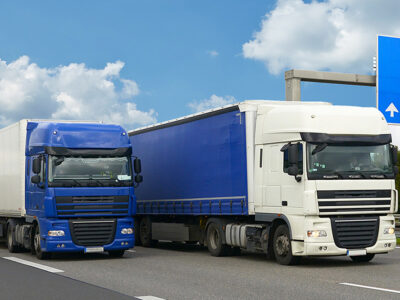
Transport keeps the economy moving
In addition to storage, transport is the most important logistics process. While storage serves exclusively to bridge a period of time, transport represents the bridging of space and time. Goods or living beings can be transported by ship (on inland waterways or the oceans), by rail, by road or in the air in airplanes . Summarized under the terms transport logistics or distribution logistics, the means of transport mentioned are dependent on the existing transport infrastructure (road network, rail network, waterways, airways, transshipment points, etc.) and the people working there.
Find the ideal transport job here!

Mode of Transport:
The dominant role of the truck
Different carriers or means of transport can be used within a transport chain. External or inter-company transports take place between companies – i.e. between suppliers and customers. Local transport bridges short distances and long-distance transport bridges longer distances between countries or continents. Therefore, ship or air transport is often used here.
On the other hand, there is internal transport, also known as intralogistics. Here, goods or goods are moved within a production site or between several company sites. Here, transport routes and travel times are mostly short.
If you look at the German freight transport statistics, it is noticeable that around three quarters of all goods transport on the road takes place by truck. This distribution of the transport performance (the modal split) can also be observed in this tendency in most other European countries. This development began in the 1960s when, as part of the economic upswing, more and more goods were shifted away from the railways and onto the roads. Politicians reacted to this process in the following years and massively renewed or expanded the road infrastructure.
As a result, even more goods traffic has shifted to the roads, which in turn made it necessary to expand motorways and federal roads. This cycle and the constant sequence of cause and effect was also forced by changing production processes in the economy. Just-in-time and just-in-sequence deliveries from suppliers to buyers are increasingly taking place on the street, as this ensures that parts or components are picked up from the supplier in the evening and delivered to the buyer the following morning. The processes during the night are similar in the food trade and in letter and parcel shipping.
Reconciling economy and environment: New ways for freight transport
The problems of this steady increase in the volume of goods transported by road have become increasingly apparent over the decades. They resulted in increasing noise and pollution from nature and people along the heavily used national and international road connections. This became all the more serious the more topographical restrictions came into play when planning motorways, e.g. in mountain regions. Road transport by truck is therefore now a European environmental policy issue, especially for the major transalpine routes from the Frejus tunnel in the west (Lyon-Turin line) via the Brenner axis (Munich-Innsbruck-Bozen-Verona) to the eastern Alpine connections Salzburg-Villach-Ljubljana or Salzburg-Graz-Zagreb. In the 1980s, as the result of a referendum, Switzerland was the only Alpine country to carry out a serious about-face by consistently shifting freight traffic, especially in transit from Germany to Italy, from road to rail with a heavy vehicle charge. Here, more and more solutions were sought in the so-called combined transport of road and rail, which meanwhile represent a viable alternative.
Combined traffic
Combined transport is now almost the “supreme discipline” of intermodal freight transport. It includes multiple transport chains in which the loading units are switched between at least two different modes of transport (road, rail, inland waterway or sea) without actually handling the goods in the loading unit. An important requirement is that these loading units are standardized, i.e. it must be either a container, a swap body or a semi-trailer. However, it can also be a complete truck that is loaded onto a special railroad car and then transported over a specific route (also known as the “rolling highway”). The provision of appropriate transshipment points (e.g. freight transport centers) makes it easier to switch loading units between modes of transport. The combined transport system allows large volumes to be bundled in the main leg over long distances, primarily by including rail and ship mass transport.
Jobs in the transport sector
The employees in transport logistics ensure that the supply chains in the shipping of goods or goods are kept running. On the one hand, this includes professional storage and onward transport, but also the optimal loading of the goods and goods onto the transport vehicles in goods transhipment points, in ports or large logistics centers. The possible uses are mostly in logistics companies or freight forwarders, but also in trading and production companies in many industries. The most common job descriptions are:
- Truck drivers or professional drivers
- forklift driver
- Employees in the container terminal
- Fleet management employee

